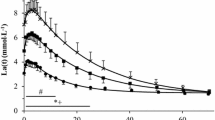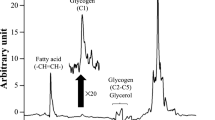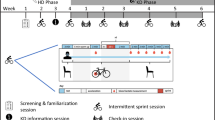Summary
Muscle ATP, creatine phosphate and lactate, and blood pH and lactate were measured in 7 male sprinters before and after running 40, 60, 80 and 100 m at maximal speed. The sprinters were divided into two groups, group 1 being sprinters who achieved a higher maximal speed (10.07±0.13 m ·s−1) than group 2 (9.75±0.10 m ·s−1), and who also maintained the speed for a longer time. The breakdown of high-energy phosphate stores was significantly greater for group 1 than for group 2 for all distances other than 100 m; the breakdown of creatine phosphate for group 1 was almost the same for 40 m as for 100 m. Muscle and blood lactate began to accumulate during the 40 m exercise. The accumulation of blood lactate was linear (0.55±0.02 mmol · s−1 ·1−1) for all distances, and there were no differences between the groups. With 100 m sprints the end-levels of blood and muscle lactate were not high enough and the change in blood pH was not great enough for one to accept that lactate accumulation is responsible for the decrease in running speed over this distance.
We concluded that 1) in short-term maximal exercise, performance depends on the capacity for using high-energy phosphates at the beginning of the exercise, and 2) the decrease in running speed begins when the high-energy phosphate stores are depleted and most of the energy must then be produced by glycolysis.
Similar content being viewed by others
References
Bergström J (1967) Local changes of ATP and phosphorylcreatine in human muscle tissue in connection with exercise. In: Chapman CB (ed) Physiology of muscular exercise. The American Heart Association, New York (Monograph 15) pp 91–96
Bergström J, Harris RC, Hultman E, Nordesjö L-O (1971) Energy rich phosphagens in dynamic and static work. In: Pernow B, Saltin B (eds) Muscle metabolism during exercise. Plenum Press, New York, pp 341–355
Harris RC, Edwards RHT, Hultman E, Nordesjö L-O, Nylind B, Sahlin K (1976) The time course of phosphorylcreatine resynthesis during recovery of the quadriceps muscle in man. Pflügers Arch 367:137–142
Hultman E, Sjöholm H, Sahlin K, Edström L (1981) Glycolytic and oxidative energy metabolism and contraction characteristics of intact human muscle. In: Human muscle fatigue: physiological mechanisms. Ciba Foundation Symposium 82. Pitman Medical, London, pp 19–40
Ikuta K, Ikai M (1972) Study on the development of maximal anaerobic power in man with bicycle ergometer. Respir J Physiol 17:151–157
Karlsson J (1971) Lactate and phosphagen concentrations in working muscle of man with special reference to oxygen deficit at the onset of work. Acta Physiol Scand [Suppl] 358
Keul J, Doll E, Keppler D (1972) Energy metabolism of human muscle. Karger, Basel
Kindermann W, Keul J (1977) Anaerobe Energiebereitstellung im Hochleistungssport. Hofmann, Schorndorf
Mader A, Heck H, Liesen H, Hollmann W (1983) Simulative Berechnungen der dynamischen Änderungen von Phosphorylerungspotential, Lactatbildung und Lactatverteilung beim Sprint. Dtsch Z Sportmed 1:14–22
Maréchal G (1981) Immediate energy sources in muscle contraction. In: Jokl E (ed) Medicine and sport. Karger, Basel, pp 1–9
Margaria R, Aghemo P, Rovelli E (1966) Measurement of muscular power (anaerobic) in man. J Appl Physiol 21:1662–1664
Murase Y, Hoshikawa T, Yasuda N, Ikegami Y, Matsui H (1976) Analysis of the changes in progressive speed during 100-meter dash. In: Komi PV (ed) Biomechanics V-B. University Park Press, Baltimore, pp 200–207
Nassar-Gentina V, Passonneau JV, Rapoport I (1981) Fatigue and metabolism of frog muscle fibres during stimulation and in response to caffeine. Am J Physiol 241:C160-C166
Näveri H, Rehunen S, Kuoppasalmi K, Tulikoura I, Härkönen M (1978) Muscle metabolism during and after strenuous intermittent running. Scand J Clin Lab Invest 38:329–336
Newsholme EA (1980) A possible metabolic basis for the control of body weight. N Engl J Med 302:400–405
Rehunen S, Härkönen M (1980) High-energy phosphate compounds in human slow-twitch and fast-twitch muscle fibres. Scand J Clin Lab Invest 40:45–54
Rehunen S, Näveri H, Kuoppasalmi K, Härkönen M (1982) High-energy phosphate compounds during exercise in human slow-twitch and fast-twitch muscle fibres. Scand J Clin Lab Invest 42:499–506
Richterich R (1968) In: Klinische Chemie. Theorie und Praxis. Karger, Basel, p 32
Sabina RL, Swain JL, Hines JJ, Holmes EW (1983) A comparison of methods for quantitation of metabolites in skeletal muscle. J Appl Physiol 55:624–627
Sahlin K, Edström L, Sjöholm H, Hultman E (1981) Effects of lactic acid accumulation and ATP decrease of muscle tension and relaxation. Am J Physiol 240:C121-C126
Sahlin K, Edström L, Sjöholm H (1983) Fatigue and Phosphocreatine depletion during carbon dioxide-induced acidosis in rat muscle. Am J Physiol 245:C15-C20
Siegel S (1956) The Mann-WhitneyU test. In: Nonparametric statistics for the behavioral sciences. McGraw-Hill, Kogakusha, Tokyo, p 116
Wilkie D (1981) Shortage of chemical fuel as a cause of fatigue: Studies by nuclear magnetic resonance and bicycle ergometry. In: Human muscle fatigue: physiological mechanisms. Ciba Foundation Symposium 82. Pitman Medical, London, pp 102–119
Author information
Authors and Affiliations
Rights and permissions
About this article
Cite this article
Hirvonen, J., Rehunen, S., Rusko, H. et al. Breakdown of high-energy phosphate compounds and lactate accumulation during short supramaximal exercise. Europ. J. Appl. Physiol. 56, 253–259 (1987). https://doi.org/10.1007/BF00690889
Accepted:
Issue Date:
DOI: https://doi.org/10.1007/BF00690889




